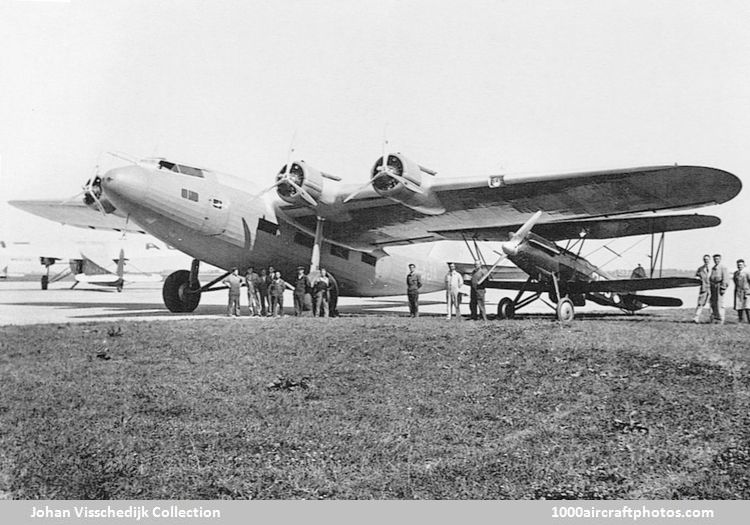07/31/2019. Remarks by Johan Visschedijk: "In 1932 KLM discussed with Fokker the requirement for a large aircraft to replace the F.XVIIIs on the Far East route, and a provisional order was given for six. The new design was known as the Fokker F.Y., and construction began in 1933. The aircraft appeared as the F.XXXVI and made its first flight on June 22, 1934. It was the first four-engine Fokker aircraft, and the biggest of all the company's transports.
The F.XXXVI was a high-wing cantilever monoplane with the engines mounted forward of the leading edge, and the landing gear was non-retractable. The wing was of standard Fokker design with wooden structure and plywood covering. Flaps were fitted, and the underside of the center section was uncovered to form the upper part of the center cabins. The fuselage was of elliptical-section and built of welded steel-tubes. The nose section was plywood covered and the rest had fabric covering.
Four 750 hp Wright Cyclone SGR-1820-F2 engines were used, and these were enclosed in NACA cowlings and drove three-blade controllable pitch Hamilton Standard metal airscrews.
Passenger accommodation was divided into four eight-seat cabins, and the type number was derived from the total accommodation for four crew and 32 passengers. To provide the best possible view the pilots' seats were on a raised platform, with the first pilot on the center line and the second pilot further aft on the starboard side. The radio operator had a rearward facing seat at a lower level on the port side. The fourth crew member was a steward. It had been planned to operate part of the Far East route at night and for this purpose the F.XXXVI was designed to provide sleeper accommodation for sixteen passengers. Aft of the passenger cabin were two lavatories and a coat cupboard. In the wing were cargo holds between the engine nacelles, and aft of the rear spar were small holds accessible from the cabins. There was also a small hold beneath the flight deck.
Three weeks after the first flight, on July 12, 1934, the aircraft was registered PH-AJA, it received its CofA the following August 27. However, the availability of the all-metal Douglas DC-2 caused KLM to abandon the idea of using the F.XXXVI on the Far East route and only one was built. It was delivered to KLM on March 27, 1935 and with a new livery and named Arend (Eagle), it went into service on European routes. It was generally used on the London-Amsterdam-Berlin route. In 1937-1938 the aircraft was leased to the French SFTA (Société Française de Transport Aériennes) which was merely a front for the buying agency of the Nationalists in the Spanish Civil War.
Surprisingly, and unlike most aircraft seconded into that conflagration, the F.XXXVI survived and was sold to Scottish Aviation at Prestwick, Scotland. That company was contracted by the military to run a flying training school and bought the PH-AJA as a navigational trainer, it was reregistered G-AFZR on September 15, 1939. The military serial HM161 was reserved, but not taken up. The aircraft was lost at Prestwick on May 21, 1940, when it failed to take off, overran the runway and was damaged beyond economic repair. Luckily there were no casualties.
